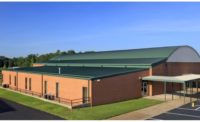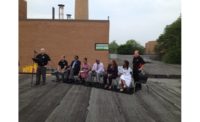
The Learning Commons and Mollie Dodd Anderson Library earned LEED Gold certification. Photos courtesy of George School. The terne-coated stainless steel roof system from Follansbee was installed.
The newest freestanding academic facility in 33 years at George School in Bucks County, Pa., incorporated many sustainable building elements into its design and construction, starting at the very top with vegetative and metal roofing systems. The 26,400-square-foot, $12.5-million Learning Commons and Mollie Dodd Anderson Library at the private Quaker boarding and day high school was designed to meet LEED Gold requirements.
The library is comprised of a glass box-like formation connected to two brick structures that match the nearby historic George School Meetinghouse, which was built in 1812. More than 60 percent of the new materials were obtained from regional resources and over 50 percent of the materials utilized for the new library contained recycled content, including the Follansbee TCS II metal roof. Furthermore, the TCS II is 100 percent recyclable.

A vegetative roof was installed in conjunction with the metal roof to provide storm water management and building insulation. The roof absorbs rain and melted slow and releases it slowly back into the stormwater drainage system at a slower rate than a traditional roof. The vegetative roof is made of a several-inch thick layer of fine material similar to lava rock and is planted with 10 different varieties of grass-like vegetation called sedum.
The vegetative roof’s design allows it to insulate the building, reducing the workload on the library’s geothermal heating and cooling system in a way that a normal roof could not. The school maintains the vegetative roof; other than watering, the roof’s maintenance consists of quarterly weeding and biannual light fertilization.

In addition to the library, the George School building includes five classrooms, a learning center, offices, a conference room and an art gallery. Additional green building features include native plant rain gardens, FSC-certified wood, low-VOC paints, carpets and glues, waterless urinals and low-flush toilets.

A vegetative roof was installed in conjunction with the metal roof to provide storm water management and building insulation.
Learning Commons and Mollie Dodd Anderson Library
Location: George School in Bucks County, Pa.Roofing: vegetative and metal roofing systems
Size: 26,400 square feet
Completed: September 2009
Architect: Bowie Gridley Architects, Washington, D.C.
General Contractor: W.S. Cumby, Springfield, Pa.
Distributor: North Coast, York, Pa.
Roofing Installer: Kraus Commercial Roofing, Inc., Ottsville, Pa.


Report Abusive Comment